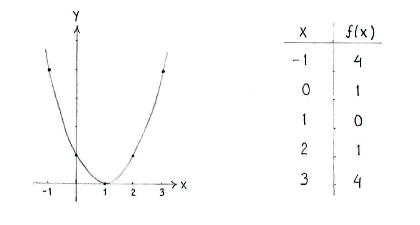Lösung 1.3:2a
Aus Online Mathematik Brückenkurs 2
(Unterschied zwischen Versionen)
K (Lösning 1.3:2a moved to Solution 1.3:2a: Robot: moved page) |
|||
| (Der Versionsvergleich bezieht 9 dazwischen liegende Versionen mit ein.) | |||
| Zeile 1: | Zeile 1: | ||
| - | { | + | Lokale Extremstellen einer Funktion sind entweder: |
| - | < | + | |
| - | {{ | + | # stationäre Stellen mit <math>f^{\,\prime}(x)=0</math>, |
| - | + | # singuläre Stellen (Theorie 1.3 E), in denen die Funktion nicht ableitbar ist, oder | |
| - | < | + | # Randstellen. |
| - | { | + | |
| - | { | + | Wir untersuchen alle drei Fälle. |
| - | <center> | + | |
| - | + | <ol> | |
| + | <li>Die Ableitung von <math>f(x)</math> | ||
| + | {{Abgesetzte Formel||<math>f^{\,\prime}(x) = 2x-2</math>}} | ||
| + | ist null, wenn <math>2x-2=0</math>, also für <math>x=1\,</math>.</li> | ||
| + | |||
| + | <li>Da die Funktion ein Polynom ist, ist sie überall differenzierbar.</li> | ||
| + | |||
| + | <li>Die Funktion ist überall definiert, also hat unser Intervall keinen Rand und es gibt keine Randstellen.</li> | ||
| + | </ol> | ||
| + | |||
| + | Also sind alle lokalen Extremstellen auch stationäre Stellen und so ist <math>x=1\,</math> die einzige Stelle, die eine Extremstelle sein kann. Mit einer Vorzeichentabelle untersuchen wir, ob die Stelle eine Extremstelle ist. | ||
| + | |||
| + | {| border="1" cellpadding="5" cellspacing="0" align="center" | ||
| + | |- | ||
| + | |width="50px" align="center" style="background:#efefef;"| <math>x</math> | ||
| + | |style="background:#efefef;"| | ||
| + | |width="50px" align="center" style="background:#efefef;"| <math>1</math> | ||
| + | |style="background:#efefef;"| | ||
| + | |- | ||
| + | |width="50px" align="center"| <math>f^{\,\prime}(x)</math> | ||
| + | |width="50px" align="center"| <math>-</math> | ||
| + | |width="50px" align="center"| <math>0</math> | ||
| + | |width="50px" align="center"| <math>+</math> | ||
| + | |- | ||
| + | |width="50px" align="center"| <math>f(x)</math> | ||
| + | |width="50px" align="center"| <math>\searrow</math> | ||
| + | |width="50px" align="center"| <math>0</math> | ||
| + | |width="50px" align="center"| <math>\nearrow</math> | ||
| + | |} | ||
| + | |||
| + | Da die Ableitung links von <math>x=1</math> negativ ist und rechts von <math>x=1</math> positiv, ist <math>x=1</math> eine lokale Minimalstelle. | ||
| + | |||
| + | Berechnen wir zusätzlich den Funktionswert in einigen Punkten, können wir die Funktion zeichnen. | ||
[[Image:1_3_2a-3(3).gif|center]] | [[Image:1_3_2a-3(3).gif|center]] | ||
Aktuelle Version
Lokale Extremstellen einer Funktion sind entweder:
- stationäre Stellen mit \displaystyle f^{\,\prime}(x)=0,
- singuläre Stellen (Theorie 1.3 E), in denen die Funktion nicht ableitbar ist, oder
- Randstellen.
Wir untersuchen alle drei Fälle.
- Die Ableitung von \displaystyle f(x)
ist null, wenn \displaystyle 2x-2=0, also für \displaystyle x=1\,.\displaystyle f^{\,\prime}(x) = 2x-2 - Da die Funktion ein Polynom ist, ist sie überall differenzierbar.
- Die Funktion ist überall definiert, also hat unser Intervall keinen Rand und es gibt keine Randstellen.
Also sind alle lokalen Extremstellen auch stationäre Stellen und so ist \displaystyle x=1\, die einzige Stelle, die eine Extremstelle sein kann. Mit einer Vorzeichentabelle untersuchen wir, ob die Stelle eine Extremstelle ist.
| \displaystyle x | \displaystyle 1 | ||
| \displaystyle f^{\,\prime}(x) | \displaystyle - | \displaystyle 0 | \displaystyle + |
| \displaystyle f(x) | \displaystyle \searrow | \displaystyle 0 | \displaystyle \nearrow |
Da die Ableitung links von \displaystyle x=1 negativ ist und rechts von \displaystyle x=1 positiv, ist \displaystyle x=1 eine lokale Minimalstelle.
Berechnen wir zusätzlich den Funktionswert in einigen Punkten, können wir die Funktion zeichnen.

